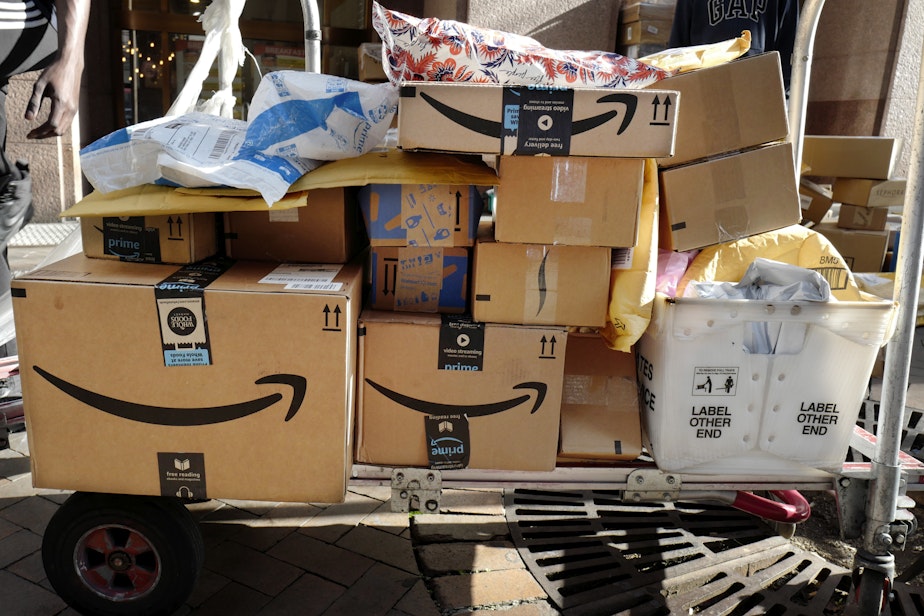Amazon's pollution grows despite massive green energy push

Amazon.com says a major investment in green power plants on four continents will help the company power its operations on 100% clean electricity within the next three years.
That’s five years ahead of the 2030 target the company set for itself to use only climate-friendly power.
“Given the growth of our business, and our mission to run 100% of Amazon’s operations on renewable energy, we aren’t slowing our renewable investments down,” CEO Andy Jassy said in a press release.
Unmentioned in the company’s press release is the fact that Amazon leaves a lot of its energy use – and pollution – uncounted.
“Time and time again, Amazon has used PR announcements like this to distract us employees and the public,” Amazon Employees for Climate Justice said by email, “and to hide important contextual information like that the company’s emissions actually increased over 36% from 2018 to 2020.”
The retail giant uses as much energy as some nations.
Sponsored
The amounts of electricity involved are so big, they aren’t measured in megawatts, but in gigawatts.
On Wednesday, the company announced 3.5 gigawatts' worth of new wind farms and solar power plants, enough to power nearly 4 million U.S. homes, according to Amazon. Once the 37 projects are operational, they are expected to boost Amazon’s green power supply by more than one-fourth.
The globe-spanning corporation now has 310 wind and solar projects in 19 countries.
Even before the purchase, Amazon claimed to be the biggest corporate buyer of green energy in the world.
While climate activists welcomed the new projects, watchdogs say Amazon drastically undercounts its actual energy use and its real-world impacts.
Sponsored
An undisclosed Amazon document obtained by the Center for Investigative Reporting shows Amazon doesn’t count the pollution associated with the vast majority of merchandise it sells, only the Amazon-branded stuff.
That approach contrasts with other major retailers like Walmart and Target that include pollution caused by the production and use of products they sell.
“It's really important that companies like Amazon are investing in renewable energy. It's also important that they address their supply-chain emissions,” said Simon Fischweicher with the nonprofit CDP (formerly the Carbon Disclosure Project).
For large businesses, the indirect emissions from their supply chains are typically 11 times greater than the direct emissions from the company’s own operations. For the retail sector, the indirect emissions can be up to 28 times greater, according to Fischweicher.
CDP has been trying, on behalf of institutional investors concerned about climate change, to get Amazon to disclose its climate impacts and its efforts to minimize them since 2004. In 2021, a decade after most of its key competitors, Amazon participated for the first time, though it did not allow its filing to be released to the public.
Sponsored
“This is not uncommon for companies submitting for the first time,” Fischweicher said.
Microsoft has been publicly disclosing its emissions since 2005.
Amazon’s filing is available to CDP’s institutional investors, which control $130 trillion in assets.
“The purpose of the CDP disclosure is really to put information in front of customers and investors to help them move capital, move money, in favor of more sustainable companies and away from those that aren't,” Fischweicher said.
The Center for Investigative Reporting obtained a copy of Amazon’s CDP filing.
Sponsored
By Amazon’s own published estimate, the company’s climate-harming emissions rose 20% in 2020.
Amazon’s business grew so fast that its clean-energy purchases failed to keep pace with its increasing demand for energy.
The company reported its sales increasing 38% in 2020 and 22% in 2021, with $469.8 billion in sales in 2021.
“We are still in the early phase of decarbonizing our business,” an Amazon sustainability website states.
Amazon officials did not respond to an interview request.




